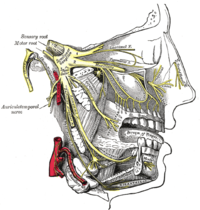
Photo from wikipedia
Abstract Trigeminal neuralgia is a condition confined to the trigeminal nerve, causing one or more branches of facial nerve pain. Surgical treatment options for trigeminal neuralgia include microvascular decompression(MVD), percutaneous… Click to show full abstract
Abstract Trigeminal neuralgia is a condition confined to the trigeminal nerve, causing one or more branches of facial nerve pain. Surgical treatment options for trigeminal neuralgia include microvascular decompression(MVD), percutaneous balloon compression (PBC), radiofrequency thermocoagulation(RF), percutaneous retrogasserian glycerol rhizotomy(PRGR), gamma knife, etc. Of these treatments, PBC is increasingly being used by clinicians for trigeminal neuralgia. PBC is a simple surgical operation performed to treat trigeminal neuralgia. Owing to its advantages, PBC is favored by many clinicians. In this study, we aimed to emphasize the need to analyze the shape of the balloon, position, compression time, and pressure, as these factors can affect the efficacy of PBC. The relief of pain by balloon compression is related to the shape of the balloon on X-ray, which is the key to the operation. Owing to continued progress and advances in current imaging technologies, clinicians revealed that the precise positioning of the foramen ovale is no longer an intraoperative problem. Instead, the anatomy of Meckel’s cave and the shape of the balloon must be the focus to achieve the best treatment effect. For clinicians, PBC is simple and is associated with a short operation time. PBC also has other advantages, such as low cost and immediate postoperative pain relief. The recurrence rate of pain post-PBC is low, despite the occurrence of facial numbness post-op. However, this side effect is reversible and does not affect daily life of the patient. In fact, the patient can be discharged 1–2 days after surgery. Overall, PBC can be considered as one of the preferred surgical methods for the treatment of primary trigeminal neuralgia. In this paper, we explain the main points of PBC operation in detail in terms of Meckel’s cave, surgical procedure, complications, discussion of the focus and new progress, etc.
Journal Title: Journal of Pain Research
Year Published: 2022
Link to full text (if available)
Share on Social Media: Sign Up to like & get
recommendations!